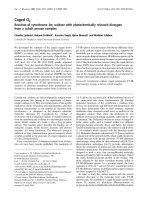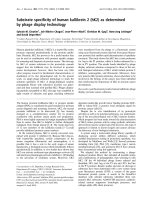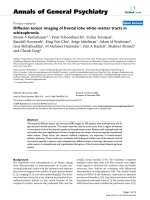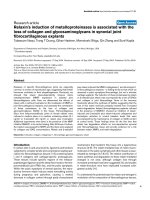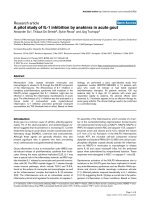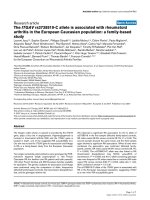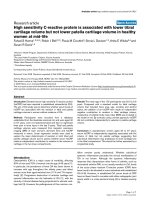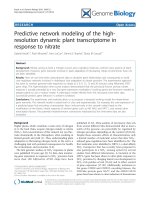Báo cáo y học: "Intensivists'''' base specialty of training is associated with variations in mortality and practice patterns" docx
Bạn đang xem bản rút gọn của tài liệu. Xem và tải ngay bản đầy đủ của tài liệu tại đây (110.76 KB, 7 trang )
Open Access
Available online />Page 1 of 7
(page number not for citation purposes)
Vol 13 No 6
Research
Intensivists' base specialty of training is associated with
variations in mortality and practice patterns
Emma O Billington
1
, David A Zygun
2
, H Tom Stelfox
2
and Adam D Peets
3
1
Department of Medicine, Foothills Medical Centre - North Tower, 9th floor, 1403 - 29thSt NW, Calgary AB, T2N 2T9, Canada
2
Department of Critical Care Medicine, Rm EG 23, 1403 - 29thST NW, Calgary AB, T2N 2T9, Canada
3
Division of Critical Care Medicine, Rm 239 Comox Building, St Paul's Hospital, 1081 Burrard St, Vancouver BC, V6Z 1Y6, Canada
Corresponding author: Adam D Peets,
Received: 5 Jun 2009 Revisions requested: 30 Jun 2009 Revisions received: 20 Oct 2009 Accepted: 29 Dec 2009 Published: 29 Dec 2009
Critical Care 2009, 13:R209 (doi:10.1186/cc8227)
This article is online at: />© 2009 Billington et al; BioMed Central Ltd
This is an open access article distributed under the terms of the Creative Commons Attribution License ( />),
which permits unrestricted use, distribution, and reproduction in any medium, provided the original work is properly cited.
Abstract
Introduction Current evidence regarding whether the staffing of
intensive care units (ICUs) with a trained Intensivist benefits
patient outcomes is discordant. We sought to determine
whether, among certified Intensivists, base specialty of training
could contribute to variation in practice patterns and patient
outcomes in ICUs.
Methods The records of all patients who were admitted to one
of three closed multi-system ICUs within tertiary care centers in
the Calgary Health Region, Alberta, Canada, during a five year
period were retrospectively reviewed. Outcomes for patients
admitted by Intensivists with base training in General Internal
Medicine, Pulmonary Medicine, or other eligible base specialties
(Anesthesia, General Surgery, and Emergency Medicine
combined) were compared.
Results ICU mortality in the entire cohort (n = 9,808) was
17.2% and in-hospital mortality was 32.0%. After controlling for
potential confounders, ICU mortality (odds ratio (OR): 0.69;
95% confidence interval (CI): 0.52 to 0.94) was significantly
lower for patients admitted by Intensivists with Pulmonary
Medicine as a base specialty of training, but not ICU length of
stay (LOS) (coefficient: 0.11; -0.20 to 0.42) or hospital mortality
(OR: 0.88; 0.68 to 1.13). There was no difference in ICU or
hospital mortality or length of stay between the three base
specialty groups for patients who were admitted and managed
by a single Intensivist for their entire ICU admission (n = 4,612).
However, we identified significant variation in practice patterns
between the three specialty groups for the number of invasive
procedures performed and decisions to limit life-sustaining
therapies.
Conclusions Intensivists' base specialty of training is
associated with practice pattern variations. This may contribute
to differences in processes and outcomes of patient care.
Introduction
Over the past decade, the literature has suggested that Inten-
sive Care Units (ICUs) staffed by physicians certified in critical
care medicine led to improved patient outcomes [1]. However,
a recent retrospective review of over 100,000 ICU admissions
found the opposite: patients managed by critical care physi-
cians were at increased risk of death compared to those man-
aged by physicians without critical care training [2]. Potential
explanations given for these discrepant results included inabil-
ity to control for unmeasured confounders and variation in phy-
sicians' practice patterns such as compliance with evidence-
based protocols and use of invasive procedures.
Practice pattern variation has been attributed to many factors,
including patient case mix and severity of illness, availability of
resources and characteristics of the individual physician them-
selves [3,4]. One physician characteristic, base specialty of
training, has been evaluated in non-ICU settings and found to
be associated with differences in resource utilization and
patient outcomes [4-6]. Within the specialty of critical care
medicine there is considerable variability in base specialty of
training for Intensivists, from internal medicine with or without
additional pulmonary training, to anesthesia, to the surgical
specialties. The training programs that serve as points of entry
into a critical care fellowship vary considerably in terms of
AGSEM: anesthesia, general surgery and emergency medicine; ANOVA: analysis of variance; APACHE II: Acute Physiology and Chronic Health Eval-
uation II score; CHR: Calgary Health Region; CI: confidence interval; DNR: do not resuscitate; GEE: generalized estimating equation; ICU: intensive
care unit; LOS: length of stay; OR: odds ratio; PGY: Postgraduate Year of training; TISS: Therapeutic Intervention Scoring System.
Critical Care Vol 13 No 6 Billington et al.
Page 2 of 7
(page number not for citation purposes)
scope and focus, which may result in considerable diversity in
practice styles within the population of practicing Intensivists.
However, to our knowledge, the effect that this core training
has on patient management and outcomes in the ICU has not
previously been investigated.
Therefore, we sought to determine the effect of Intensivists'
base specialty of training on practice patterns and patient out-
comes in the ICU.
Materials and methods
Study Design
The Calgary Health Region (CHR) (population 1,197,848 as
of 2006) contains three closed medical-surgical ICUs, each in
academic centers affiliated with the University of Calgary.
While all units manage critically ill medical and surgical
patients, certain services have been regionalized. One unit is
a trauma/neurosurgical referral centre with 25 beds, the sec-
ond a vascular surgery referral centre that has 14 beds, and
finally a 10-bed medical-surgical unit. Each ICU is staffed by
attending physicians who are board-certified in critical care
medicine, and do one week shifts at a time. Registered nurses
are typically assigned one patient each, but may look after two
patients if short-staffed.
When on service, Intensivists perform daily bedside rounds.
While residents and fellows have input on the decision-making
process, attending Intensivists have full responsibility for
development and implementation of the daily healthcare plan
on each patient in the ICU. Intensivists are on-call 24 hours per
day, with call being performed from home at night. They regu-
larly return during the night to oversee trainees. Residents from
nearly every training program in the CHR, ranging from Post-
graduate Year (PGY) 1 to PGY 4, complete rotations in each
ICU and perform in-house overnight call. Every night has resi-
dent coverage, with residents averaging call once every fourth
night. Approximately 50% of the year, an ICU fellow will also
be on service at each of the sites, and will complete call from
home once every three nights. Decisions to perform invasive
procedures are made in conjunction with the Intensivist and
depending on the experience level of the trainee, the Intensiv-
ist may or may not directly supervise the procedure. A record
of all procedures is documented in the ICU electronic data-
base, TRACER.
All patients admitted to CHR ICUs between August 1, 2002
and July 31, 2007 were identified from TRACER. If a patient
was admitted to ICU more than once during the study period,
one of the visits was randomly selected to be included in the
analysis. During the study period, there were no major
changes to the Regional Healthcare System that affected how
care was delivered in the ICU.
ICU physicians were classified by their base specialty of train-
ing into one of three groups: Internal Medicine (Internal Medi-
cine Group), Internal Medicine plus a fellowship in Pulmonary
Medicine (Pulmonary Group), or Anesthesia, General Surgery
and Emergency Medicine, which due to small numbers were
analyzed together (AGSEM group). Over the study period
three Intensivists left Calgary and six were hired.
Patients were grouped according to the base specialty of the
Intensivist who admitted them to the ICU, and outcomes were
compared between these groups. The primary outcome meas-
ures were ICU mortality and length of stay (LOS). We elected
to use these as primary outcomes instead of the more tradi-
tional hospital mortality and LOS in order to focus on the out-
comes that would maximally reflect the care provided by
Intensivists and attempt to minimize effects of other variables
that may influence outcomes outside of the ICU. Secondary
outcomes consisted of in-hospital mortality, hospital LOS,
number of invasive procedures performed and limitation of life
support therapies, as judged by the number of patients
changed from full care to do not resuscitate (DNR) during their
ICU admission. The following invasive procedures were
tracked: endotracheal intubation, chest tube, thoracentesis,
central line, arterial line, pulmonary artery catheter insertion,
lumbar puncture, bone marrow biopsy and paracentesis. Most
procedures are done by housestaff, but direct or indirect
supervision is provided by the attending Intensivist in the
majority of cases.
In analysis of the entire cohort, only the identities of the admit-
ting physicians were accounted for, despite the fact that many
patients were cared for by more than one Intensivist while in
ICU. A priori, we made the decision to also complete a sub-
group analysis on those patients who were admitted and man-
aged by a single Intensivist for their entire ICU admission in
order to provide a more specific analysis of the impact that
each Intensivist group may have on patient outcomes.
Analysis
Means for continuous data were compared using the Kruskal-
Wallis test or one-way analysis of variance (ANOVA) where
appropriate. Categorical data was compared with use of
Fisher's Exact test.
Given the significant heterogeneity in baseline patient and
Intensivist characteristics, the use of regression analysis was
appropriate. However, typical regression models are unable to
account for clustering of patients, so we utilized generalized
estimating equations (GEE) to control for correlation between
individual observations. For these analyses, two sources of
correlation were identified and accounted for in each model:
those related to the hospital site the patient was admitted to
and those related to the individual physician who cared for the
patient. To evaluate variables associated with ICU and hospital
mortality, we used a model built on a binomial distribution with
a logit link function. As ICU and Hospital LOS were skewed,
they were natural-log transformed to approximate statistical
Available online />Page 3 of 7
(page number not for citation purposes)
normality, and subsequently entered into separate linear scale
response models with identity as the link function. Evaluation
of number of procedures performed utilized GEE based on a
Poisson distribution, while the model for change in level of
care was built on a binomial distribution.
Given the size of the cohort, all relevant variables felt to poten-
tially impact the dependent variable in each of the models
were included [7]. Therefore, the following independent varia-
bles were included in all of the models: patient age, gender,
Acute Physiology and Chronic Health Evaluation II (APACHE
II) score, mean Therapeutic Intervention Scoring System
(TISS) over first 24 hours of admission to ICU, year of admis-
sion, time of year of admission (by 28-day block to coincide
with trainees' length of rotation), level of care at time of admis-
sion (full care or DNR) and discharge, admission diagnosis,
Intensivist gender, Intensivist base specialty of training, years
since completion of Critical Care Medicine Fellowship, and
ICU occupancy at admission and at discharge. In addition, the
number of invasive procedures performed per patient was
included as an independent variable in all models except the
one where it was the dependent variable, and ICU LOS was
included as an independent variable in models assessing ICU
and hospital mortality, number of invasive procedures per-
formed, and the change in level of care. Separate analyses
with adjustment for the variables listed above were completed
for the entire cohort and the subgroup of patients who were
admitted and managed by a single Intensivist. Detailed results
of these analyses are provided in Additional file 1.
All P values < 0.05 were considered significant. Statistical
analysis was done using Stata version 8.0 (College Station,
Texas, USA) and SUDAAN version 9.0 (RTI International,
Raleigh, North Carolina, USA). Prior to initiation of this study,
ethical approval was obtained from the Conjoint Health
Research Ethics Board at the University of Calgary. Permis-
sion for waiver of consent was obtained as this was a retro-
spective review of a database and all data was made
anonymous at the time of acquisition from TRACER.
Results
During the study period 9,808 patients had 11,663 ICU
admissions, with 1,283 patients being admitted more than
once. The mean patient age of the final cohort was 56.8 years;
most were male (57.8%) with a mean admission APACHE II
score of 23.2 (Table 1). A total of 26 Intensivists (92% male)
admitted patients during the study period. Their base special-
ties of training were Internal Medicine (n = 12), Pulmonary (n
= 8), and AGSEM (n = 6) (Table 2). Each had completed fur-
ther training in Critical Care Medicine, with 23 completing
dedicated multidisciplinary critical care fellowships and three
surgical critical care fellowships. There were significant differ-
ences in both the baseline characteristics of the study cohort
and the subgroup of patients cared for by a single Intensivist
for their entire ICU stay (n = 4,612) according to physician
base specialty (Table 1).
Entire Cohort Analysis
For the entire cohort, ICU mortality was 17.2%, in-hospital
mortality was 32.0%, median ICU LOS was 2.9 days, and
median hospital LOS was 13.5 days (Table 3). After control-
ling for baseline patient, physician and ICU characteristics,
patients admitted by a physician from the Pulmonary group
had significantly less chance of dying in the ICU (OR: 0.69;
95% CI: 0.52 to 0.94) compared to those admitted by the
AGSEM group. There were no differences in patients' ICU
LOS, or hospital mortality or LOS. The Pulmonary group per-
formed fewer invasive procedures (OR 0.96 (0.92 to 1.0)),
while Intensivists in the Internal Medicine group were more
likely to change patients to DNR status (OR 1.13 (1.02 to
1.24)).
Subgroup Analysis
For the subgroup of patients cared for by one Intensivist dur-
ing their entire ICU stay, ICU mortality was 19.9%, in-hospital
mortality was 33.0%, median ICU LOS was 1.7 days, and
median hospital LOS was 8.9 days (Table 3). Analyses dem-
onstrated no differences in either ICU or hospital mortality or
LOS between the three groups of specialists. However, in
keeping with the entire cohort, the Pulmonary group per-
formed fewer procedures (OR 0.94 (0.90 to 0.99)) and the
Internal Medicine group transitioned more patients to DNR
status (OR 1.38 (1.09 to 1.66)).
Discussion
Since previous studies have found that board-certified Inten-
sivists may have either a positive or negative impact on patient
outcome in ICUs [1,2], we sought to examine characteristics
of the physicians within this highly trained group to further
explore what factors may contribute to these discrepant out-
comes. The results of our study suggest that the use of inva-
sive procedures, limitation of life support measures and ICU
mortality appear to vary according to Intensivists' base spe-
cialty of training.
While our results should only be viewed as hypothesis-gener-
ating given the retrospective design of the study, there are a
number of factors that make the results plausible. The first is
that this is not a new phenomenon. Previous reports have sug-
gested that physicians with training in a specific area of medi-
cine tend to have more favorable outcomes with conditions
that fall into their area of expertise than do generalists [8-12].
Since over 30% of the admitting diagnoses in our ICUs are
related to the pulmonary system, the Pulmonary Medicine
group may have an intrinsic advantage over the Internal Medi-
cine and AGSEM groups. In addition, extra years spent as a
trainee may provide Intensivists with Pulmonary Medicine
backgrounds valuable clinical experience that helps them
Critical Care Vol 13 No 6 Billington et al.
Page 4 of 7
(page number not for citation purposes)
diagnose and manage complex ICU patients more effectively
than those with Internal Medicine backgrounds.
The second is that we observed a significant difference in the
propensity to limit life-sustaining therapy between the three
groups. While many factors play into a decision to limit life sup-
port, it has previously been shown that the identity of the indi-
vidual physician is one of the most, if not the most, important
determinants [13]. Different practice patterns for limitation of
life support based on Intensivist's base specialty of training
have not previously been described, but should now be further
evaluated.
A third factor that helps explain our results is that because the
Pulmonary group performed significantly less invasive proce-
dures than the other two groups, their patients may have been
at less risk to develop potential life-threatening complications
[14-16]. While we had initially hypothesized that the decrease
in the number of procedures was due to members of the Pul-
monary group having more years of clinical experience and
Table 1
Patient characteristics
Entire cohort of patients Patients cared for by a single Intensivist during ICU stay
Overall
(n = 9808)
Internal
Medicine
(n = 4146)
Pulmonary
(n = 3906)
AGSEM
(n = 1756)
p value* Overall
(n = 4612)
Internal
Medicine
(n = 1944)
Pulmonary
(n = 1844)
AGSEM
(n = 824)
p value*
Mean age in years
(± SD)
56.8 (18.8) 56.0
(18.9)
58.4
(18.2)
55.2
(19.7)
<0.001 57.1 (19.2) 56.6 (19.4) 58.2
(18.6)
55.7 (19.9) <0.01
Male (%) 57.8 58.0 56.8 59.9 NS 56.0 55.5 56.0 57.0 NS
Mean admission
APACHE II (± SD)
23.2
(9.1)
23.1
(8.9)
23.4
(9.3)
22.7
(8.9)
< 0.05 22.2 (9.4) 22.5
(9.3)
21.9
(9.4)
21.8 (9.3) NS
Mean admission TISS
(± SD)
35.7 (13.3) 36.3
(13.4)
34.5
(13.1)
36.7
(13.3)
<0.001 33.1 (13.3) 33.7 (13.5) 31.7
(12.8)
34.4 (13.5) <0.001
Admitting diagnosis
(% of total
admissions within
each group)
Pulmonary 30.7 30.3 32.4 28.3 <0.01 28.5 28.6 29.4 26.8 <0.01
Cardiovascular 23.4 21.0 27.3 20.3 <0.001 24.3 21.9 28.0 22.1 <0.001
Neurologic 13.6 16.7 10.2 13.9 <0.001 13.6 16.3 10.2 15.0 <0.01
Gastrointestinal 10.7 10.2 11.0 10.7 NS 11.3 11.5 11.4 10.6 NS
Trauma 9.2 10.2 5.4 15.2 <0.001 6.5 7.4 3.9 10.3 <0.001
Poisoning 5.6 4.6 6.5 6.1 <0.01 7.7 6.6 8.5 8.7 <0.01
Other 6.8 6.9 7.2 5.5 <0.01 8.0 7.7 8.6 6.6 NS
Admit level of care
(% DNR)
9.5 9.4 9.8 9.1 NS 11.8 12.4 11.2 11.9 NS
Discharge level of
care (% DNR)
22.3 22.7 22.4 21.2 NS 21.4 23.6 19.4 20.5 <0.01
ICU occupancy at
admission (%)
84.0 83.3 84.3 85.1 <0.001 83.6 83.1 83.5 84.8 <0.05
AGSEM = Intensivists with base specialty training in Anesthesia, General Surgery or Emergency Medicine; APACHE = Acute Physiology and Chronic Health
Evaluation Score; DNR = Do Not Resuscitate; ICU = Intensive Care Unit; n/a = not applicable; SD = Standard Deviation; TISS = Therapeutic Intervention Scoring
System
* Reflects comparisons between the three specialty groups
Table 2
Physician characteristics by base specialty of training
Overall Internal Medicine Pulmonary AGSEM p value*
Number of physicians 26 12 8 6 n/a
Median years since critical care
medicine certification (IQR)
12
(5 to 16)
9
(4 to15)
15
(12 to 18)
7
(3 to 10)
<0.001
Mean weeks of service per year (± SD) 14.5 (5.8) 15.6
(6.0)
15.4
(5.5)
9.8
(2.9)
<0.001
AGSEM = Intensivists with base specialty training in Anesthesia, General Surgery or Emergency Medicine; IQR = Interquartile range; n/a = not
applicable; SD = Standard Deviation;
* Reflects comparisons between the three specialty groups
Available online />Page 5 of 7
(page number not for citation purposes)
their greater comfort level in diagnosing and managing
patients based on clinical examination and non-invasive tests
alone, this turned out not to be the case according to our sta-
tistical models because we adjusted for number of years in
practice. However, the lower number of procedures per-
formed may still be a surrogate for an overall more conserva-
tive practice pattern that may benefit their patients, but that is
not easily measured by a single variable such as years in prac-
tice. Future research should explore other areas of potential
practice pattern variation based on Intensivist base specialty
of training beyond the two variables that we elected to meas-
ure in this study.
While it is plausible for a physician's training to impact their
patients' outcomes, it is important to note that there are limita-
tions with our study that need to be taken into consideration
when interpreting the results. First, attributing causation is
challenging because of the multiple variables that impact
patient outcomes in ICUs beyond the Intensivist. Second, for
patients in the entire cohort that had more than one Intensivist
involved in their care, we attributed patient outcomes only to
the admitting ICU attending physician. While we justified this
decision based upon the evidence that the first 24 to 48 hours
of a patient's care often sets the trajectory for both short and
long-term patient outcomes [17-21], this did not allow us to
account for management decisions made later in the ICU
course by other Intensivists. We specifically performed the
subgroup analysis to attempt to address this issue; however,
since these patients represent less than half of the patients
admitted to our ICUs, it is difficult to generalize the results.
A third limitation was our inability to control for the contribution
of residents, ICU fellows and members of the multidisciplinary
team to patient care; however, it has previously been shown
that outcomes do not change depending on whether a critical
care fellow is involved in patient care [22]. Additionally, the
generalizability of our results may be limited because it was
performed in three Canadian teaching hospitals and because
the mix of base specialties was heavily weighted towards Inter-
nal Medicine and Pulmonary Medicine. Finally, given the size of
our cohort, while some of our results are considered statisti-
cally significant, one could argue whether the differences
should be considered clinically significant; the difference in
the number of invasive procedures performed would be an
example of this.
Taken in the context of these limitations, we believe that the
results of our study still have potential implications for the way
in which critical care medicine is administered. First, training
programs need to be aware that a trainee's base specialty may
substantially influence the knowledge and skills with which
they enter a fellowship program and hence their training needs
and fellowship experience. Second, given predictions of a sig-
nificant shortage of Intensivists in years to come [23,24], there
may be pressure to preferentially recruit trainees from base
specialties with a shorter duration of training, for example Inter-
nal Medicine. While this could deliver more Intensivists to the
workforce more quickly, prospective multicentre investigations
are first warranted to further assess the potential impact of
physicians' base specialty of training on patient outcomes.
Third, although care in most ICUs is provided by a highly
trained multidisciplinary team with the assistance of evidence-
based protocols, individual physician leadership clearly influ-
ences patient care.
Table 3
Outcome measures based on physician specialty
Entire cohort of patients Patients cared for by a single Intensivist during ICU stay
Measures Overall IM Pulm AGSEM p value* Overall IM Pulm AGSEM p value*
ICU Mortality (%) 17.2 17.9 16.0 18.0 <0.05 19.9 21.8 17.4 20.8 NS
Median ICU LOS
in Days (IQR)
2.9
(1.4 to 6.7)
2.9
(1.5 to 6.8)
2.8
(1.4 to 6.6)
2.8
(1.3 to 6.6)
NS 1.7
(0.9 to 2.8)
1.7
(0.9 to 2.8)
1.7
(0.9 to 2.7)
1.6
(0.8 to 2.7)
NS
Hospital Mortality
(%)
32.0 32.7 31.4 31.7 NS 33.0 36.5 28.8 34.0 NS
Median Hospital
LOS in Days (IQR)
13.5
(5.7 to 30.7)
14.3
(5.7 to 32.4)
13.8
(6.1 to 30.9)
13.7
(5.9 to 32.8)
NS 8.9
(3.3 to 19.0)
8.4
(2.8 to 19.2)
8.8
(3.8 to 18.9)
8.4
(3.3 to 18.7)
NS
Patients changed
from Full Care to
DNR (%)
12.8 13.3 12.6 12.1 <0.05 9.6 11.2 8.2 8.6 <0.05
Median Number of
Procedures (IQR)
3
(2 to 5)
3
(2 to 5)
3
(2 to 4)
3
(2 to 5)
<0.05 2
(2 to 3)
3
(2 to 4)
2
(1 to 3)
3
(2 to 4)
<0.05
AGSEM = Intensivists with base specialty training in Anesthesia, General Surgery or Emergency Medicine; DNR = Do Not Resuscitate; ICU =
Intensive Care Unit; IM = Intensivists with base specialty training in Internal Medicine; IQR = Interquartile Range; LOS = Length of Stay; NS =
non-significant; Pulm = Intensivists with base specialty training in Pulmonary Medicine.
* Reflects comparisons between the three specialty groups using Generalized Estimating Equations
Critical Care Vol 13 No 6 Billington et al.
Page 6 of 7
(page number not for citation purposes)
Given the potential impact that Intensivist base specialty train-
ing may have on physician practice patterns, resource utiliza-
tion, patient outcomes, and future training requirements for
Intensivists, further investigations are warranted to explore our
findings.
Conclusions
Our results suggest that an Intensivist's base specialty of train-
ing may impact patient outcomes and practice patterns. This
may help explain the inconsistent results seen with previous
investigations assessing the impact of Intensivists' care on
ICU patients.
Competing interests
The authors declare that they have no competing interests.
Authors' contributions
All authors were involved in development of the research ques-
tion and study design. EOB contributed to data acquisition,
data analysis, and drafting of the manuscript. DAZ and HTS
contributed to data analysis. ADP contributed to data acquisi-
tion, data analysis, and drafting of the manuscript. All authors
revised the manuscript critically for important intellectual con-
tent and have approved the final copy.
Additional files
Acknowledgements
We would like to thank Mary Hollingwood for her help with the statistical
analyses.
References
1. Pronovost PJ, Angus DC, Dorman T, Robinson KA, Dremsizov TT,
Young TL: Physician staffing patterns and clinical outcomes in
critically ill patients. JAMA 2002, 288:2151-2162.
2. Levy MM, Rapoport J, Lemeshow S, Chalfin DB, Phillips G, Danis
M: Association between critical care physician management
and patient mortality in the intensive care unit. Ann Intern Med
2008, 148:801-809.
3. Burns LR, Wholey DR: The Effects of patient, hospital, and phy-
sician characteristics on length of stay and mortality. Med
Care 1991, 29:251-271.
4. Greenfield S, Nelson EC, Zubkoff M, Manning W, Rogers W, Krav-
itz RL, Kellar A, Tarlov AR, Ware JE: Variations in resource utili-
zation among medical specialties and systems of care.
Results from the medical outcomes study. JAMA 1992,
267:1624-1630.
5. Lindenauer PK, Rothberg MB, Pekow PS, Kenwood C, Benjamin
EM, Auerbach AD: Outcomes of care by hospitalists, general
internists and family physicians. N Engl J Med 2007,
357:2589-2600.
6. Harrold LR, Field TS, Gurwitz JH: Knowledge, patterns of care,
and outcomes of care for generalists and specialists. J Gen
Intern Med 1999, 14:499-511.
Key messages
• Intensivists' base specialty of training is associated with
practice pattern variation.
• This may be one factor that contributes to the differ-
ences in processes and outcomes of patient care.
• Further prospective investigations are warranted to
explore the impact that this may have on patient care
and training requirements for Intensivists.
The following Additional files are available online:
Additional file 1
Additional file 1 is available with the online version of this
paper; it contains a total of 12 tables providing more
detailed results of the analyses. Tables S1 and S2 list the
variables associated with ICU mortality and their
corresponding odds ratios for the entire cohort and
subgroup, respectively; Tables S3 and S4 list the
variables associated with ICU LOS and their
corresponding odds ratios for the entire cohort and
subgroup, respectively; Tables S5 and S6 list the
variables associated with hospital mortality and their
corresponding odds ratios for the entire cohort and
subgroup, respectively; Tables S7 and S8 list the
variables associated with hospital LOS and their
corresponding odds ratios for the entire cohort and
subgroup, respectively; Tables S9 and S10 list the
variables associated with the likelihood of an invasive
procedure being performed and their corresponding
odds ratios for the entire cohort and subgroup,
respectively; and Tables S11 and S12 list the variables
associated with the likelihood of changing a patient's
code status to DNR and their corresponding odds ratios
for the entire cohort and subgroup, respectively.
See />supplementary/cc8227-S1.doc
Available online />Page 7 of 7
(page number not for citation purposes)
7. Sun G-W, Shook TL, Kay GL: Inappropriate use of bivariate
analysis to screen risk factors for use in multivariable analysis.
J Clin Epidemiol 1996, 49:907-916.
8. Roe MT, Chen AY, Rajendra HM, Yun L, Brindis RG, Smith SC,
Rumsfeld JS, Gibler WB, Ohman EM, Peterson ED: Influence of
inpatient service specialty on care processes and outcomes
for patients with non-ST segment elevation acute coronary
syndromes. Circulation 2007, 116:1153-1161.
9. Levetan CS, Passaro MD, Jablonski KA, Ratner RE: Effect of phy-
sician specialty on outcomes in diabetic ketoacidosis. Diabe-
tes Care 1999, 22:1790-1795.
10. Jollis JG, DeLong ER, Peterson ED, Muhlbaier LH, Fortin DF, Califf
RM, Mark DB: Outcome of acute myocardial infarction accord-
ing to the specialty of the admitting physician. N Engl J Med
1996, 335:1880-1887.
11. Stone VE, Mansourati FF, Poses RM, Mayer KH: Relation of phy-
sician specialty and HIV/AIDS experience to choice of guide-
line-recommended antiretroviral therapy. J Gen Intern Med
2001, 16:360-368.
12. Ko CW, Kelley K, Meyer KE: Physician specialty and the out-
comes and cost for end-stage liver disease. Am J Gastroen-
terol 2001, 96:3411-3418.
13. Garland A, Connors AF: Physicians' influence over decisions to
forego life support. J Palliat Med 2007, 10:1298-1305.
14. Polderman KH, Girbes AJ: Central venous catheter use. Part 1:
mechanical complications. Intensive Care Med 2002, 28:1-17.
15. Polderman KH, Girbes AJ: Central venous catheter use. Part 2:
infectious complications. Intensive Care Med 2002, 28:18-28.
16. Matthay MA, Chatterjee K: Bedside catheterization of the pul-
monary artery: risks compared with benefits. Ann Intern Med
1988, 109:826-834.
17. Kumar A, Roberts D, Wood K, Light B, Parrillo JE, Sharma A, Sup-
pes R, Feinstein D, Zanotti S, Taiberg L, Gurka D, Kumar A,
Cheang M: Duration of hypotension before initiation of effec-
tive antimicrobial therapy is the critical determinant of survival
in human septic shock. Crit Care Med
2006, 34:1589-1596.
18. Boersma E, Maas AC, Deckers JW, Simoons M: Early thrombo-
lytic treatment in acute myocardial infarction: reappraisal of
the golden hour. Lancet 1996, 348:771-775.
19. Rivers E, Nguyen B, Havstad S, Ressler J, Muzzin A, Knoblich B,
Peterson E, Tomlanovich M: Early goal-directed therapy in the
treatment of severe sepsis and septic shock. N Engl J Med
2001, 345:1368-1377.
20. Blow O, Magliore L, Claridge JA, Butler K, Young JS: The golden
hour and the silver day: detection and correction of occult
hypoperfusion within 24 hours improves outcome from major
trauma. J Trauma 1999, 47:964-969.
21. Lerner EB, Moscati RM: The Golden Hour: scientific fact or
medical "urban legend?". Acad Emerg Med 2001, 8:758-776.
22. Peets AD, Boiteau PJ, Doig CJ: Effect of critical care medicine
fellows on patient outcome in the intensive care unit. Acad
Med 2006, 81:S1-S4.
23. Krell K: Critical care workforce. Crit Care Med 2008,
36:1350-1353.
24. US Department of Health and Human Services: The Critical Care
Workforce: A Study of the Supply and Demand for Critical Care
Physicians. [ />care.pdf]. Accessed on January 8, 2009
